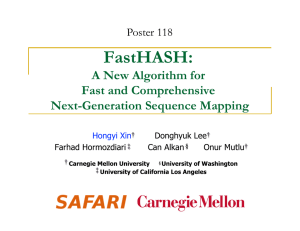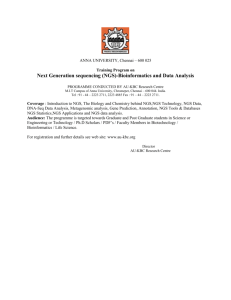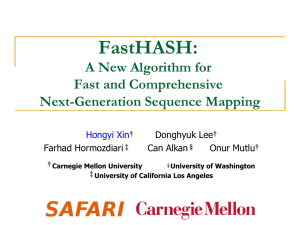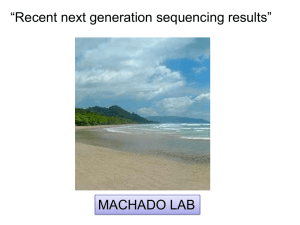Delivering Support Services for The National Grid Service , Stephen McAllister,
advertisement
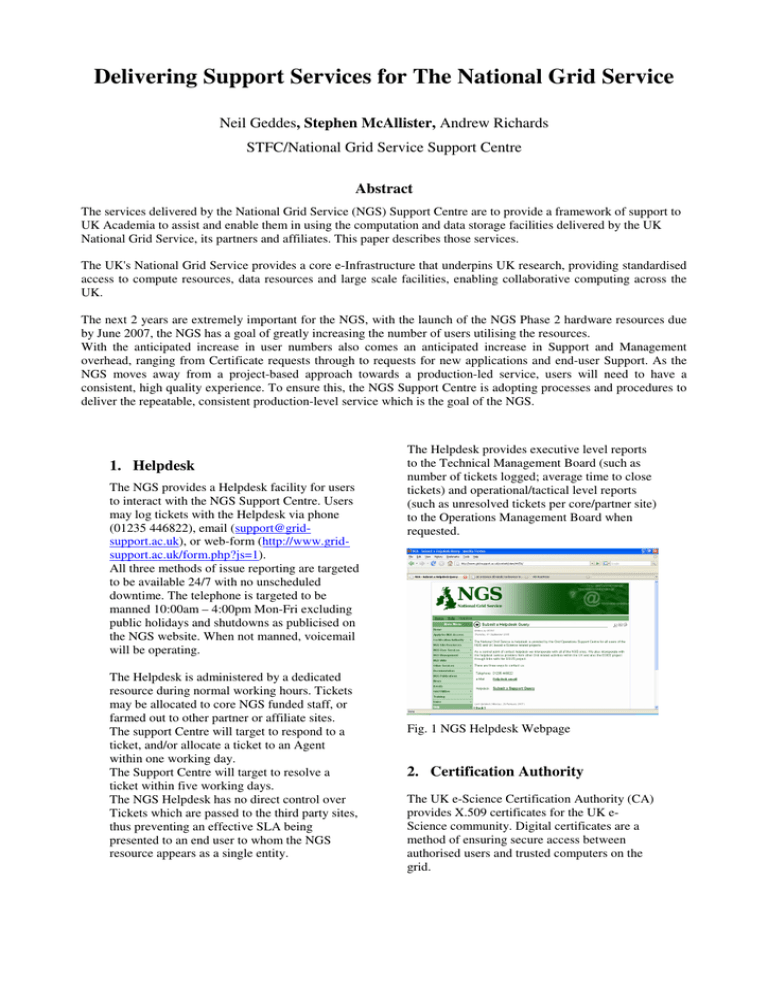
Delivering Support Services for The National Grid Service Neil Geddes, Stephen McAllister, Andrew Richards STFC/National Grid Service Support Centre Abstract The services delivered by the National Grid Service (NGS) Support Centre are to provide a framework of support to UK Academia to assist and enable them in using the computation and data storage facilities delivered by the UK National Grid Service, its partners and affiliates. This paper describes those services. The UK's National Grid Service provides a core e-Infrastructure that underpins UK research, providing standardised access to compute resources, data resources and large scale facilities, enabling collaborative computing across the UK. The next 2 years are extremely important for the NGS, with the launch of the NGS Phase 2 hardware resources due by June 2007, the NGS has a goal of greatly increasing the number of users utilising the resources. With the anticipated increase in user numbers also comes an anticipated increase in Support and Management overhead, ranging from Certificate requests through to requests for new applications and end-user Support. As the NGS moves away from a project-based approach towards a production-led service, users will need to have a consistent, high quality experience. To ensure this, the NGS Support Centre is adopting processes and procedures to deliver the repeatable, consistent production-level service which is the goal of the NGS. 1. Helpdesk The NGS provides a Helpdesk facility for users to interact with the NGS Support Centre. Users may log tickets with the Helpdesk via phone (01235 446822), email (support@gridsupport.ac.uk), or web-form (http://www.gridsupport.ac.uk/form.php?js=1). All three methods of issue reporting are targeted to be available 24/7 with no unscheduled downtime. The telephone is targeted to be manned 10:00am – 4:00pm Mon-Fri excluding public holidays and shutdowns as publicised on the NGS website. When not manned, voicemail will be operating. The Helpdesk is administered by a dedicated resource during normal working hours. Tickets may be allocated to core NGS funded staff, or farmed out to other partner or affiliate sites. The support Centre will target to respond to a ticket, and/or allocate a ticket to an Agent within one working day. The Support Centre will target to resolve a ticket within five working days. The NGS Helpdesk has no direct control over Tickets which are passed to the third party sites, thus preventing an effective SLA being presented to an end user to whom the NGS resource appears as a single entity. The Helpdesk provides executive level reports to the Technical Management Board (such as number of tickets logged; average time to close tickets) and operational/tactical level reports (such as unresolved tickets per core/partner site) to the Operations Management Board when requested. Fig. 1 NGS Helpdesk Webpage 2. Certification Authority The UK e-Science Certification Authority (CA) provides X.509 certificates for the UK eScience community. Digital certificates are a method of ensuring secure access between authorised users and trusted computers on the grid. The UK e-Science CA is the CA for Grid and eScience activities in the UK. It is accredited by the International Grid Trust Federation (IGTF), meaning it is internationally recognised to issue certificates to people and computers in the UK. The CA authenticates users through a wide network of Registration Authorities (RAs). Users are initially authenticated via means of photo ID (such as a passport photo or university card). See www.ngs.ac.uk for full details of the process. The CA accepts requests for certificates through the NGS website (www.ngs.ac.uk). Certificate signing (securely generating requested certificates) is performed every working day by a member of the core NGS Support staff. There are nominally five people at RAL authorised to/capable of signing certificates. Note, however, that the elapsed time between a request for an initial certificate and the certificate being generated and dispatched is usually greater than one day, due to the requirement of a face to face meeting between the applicant and their local Registration Authority. Statistics showing the numbers of Certificates generated are available here on the NGS website at http://www.gridsupport.ac.uk/content/view/162/89/ Fig. 2 CA Website 3. Registration Authority A Registration Authority (RA) is a body which approves a user’s request for a digital certificate from the UK Certification Authority. An RA Operator performs the role of validating a user’s identity and passing that information to the Certification Authority. In summary, a user must present photographic ID to their local RA Operator to verify their identity before their request for a digital certificate is approved. A process is followed by which the RA Operator interacts with the Certification Authority in order for the user to obtain a certificate. Full details are available from www.ngs.ac.uk. The NGS Support Centre is responsible for the creation of new Registration Authorities, and ensuring the RAs understand their roles and responsibilities. Support Centre Staff act as RA Operators for Rutherford Appleton Laboratory. The NGS Support Centre provides training course for RA Operators (see section on Training), and manages RAs and RA Operators. The NGS Support Centre will target to audit at least six RAs per year through a site visit to ensure they are adhering to the documented process and procedures. The results of the audits are made available to the quarterly NGS Board Review. 4. NGS Site Resources The National Grid Service site resources comprise the 4 founding members of the STFC (formerly CCLRC), University of Oxford, White Rose Grid - Leeds and University of Manchester, plus the national HPC facilities of CSAR and HPCx and a growing number of partner and affiliate sites. Each site may specialise as a compute or data node (or both). The role of the Support Centre is to manage the information relating to each site, oversee the site’s Service Level Description review process, and collate and publish site specific information. Information on each site’s resources is published on the NGS website, at pages from http://www.gridsupport.ac.uk/content/category/12/51/88/ (correct at time of writing). Published information contains detail on; the resources available at each site; hostnames; available applications; and details relevant for each site which they choose to publish. Each core and partner site must also publish a Service Level Description which is agreed by the Technical Board: these documents are available on the NGS website. 6. Website Fig. 3 RAL Site Resources 5. User Support The Support Centre provides the following services: • Guidance and assistance for users applying for access and using the NGS resources from initial application for a certificate through to using an application/accessing data on the NGS. • Users are set up on ngsannounce@jiscmail.ac.uk and ngsusers@jiscmail.ac.uk mailing lists (a conduit for information flow from the Support Centre to the user-base, and between users). • Users also have a Storage Resource Broker (SRB) account created for them. Note that users apply for use of NGS resources via an application through the NGS Support Centre which is fed through a peer review process to validate the research the user wishes to conduct on the NGS resources. • Guidance and advice for new sites wishing to join the NGS as a partner or affiliate, through documentation (Joining Guide), verbal communication, and a ‘Buddy’ system (see www.ngs.ac.uk for full details on difference between partner and affiliate, and joining information). • Details of applications and software installed at NGS sites. See NGS website for full details (at time of writing http://www.gridsupport.ac.uk/content/view/167/92/ ). The Support Centre provides content management for the NGS website. The website holds a vast range of information from general information on the NGS, to Certification, to site and user joining information, to site resource details, to tools for using and accessing the grid and much more. The site is regularly updated to include latest information, for example news articles, events, vacancies, reports on numbers of Certificates generated. The site is linked to the Helpdesk Knowledgebase repository, which stores solutions to frequently asked questions, common problems, hints and tips etc. The target audiences/users of the website are: new NGS users; experienced NGS users; resource providers; NGS partner and affiliate staff; anyone interested in UK Grid computing. In addition to ‘regular’ website content management, the site also contains areas which are secured through use of certificates and are used to host secure content such as minutes of Board meetings. Reports on website usage, for example hits per pages, are available. Fig. 4 NGS Website Homepage 7. Training The National Grid Service provides training through the National e-Science Centre (NeSC) and directly through the support centre. The National Grid Service Support Centre runs regular courses designed for new RA managers and Operators, which offer comprehensive training on the procedures and tasks that RA Operators will encounter. The NGS provides end-user and developer training courses through the National e-Science Centre (training-support@nesc.ac.uk). The Support Centre liaises with NeSC to provide advice on training requirements, content and needs. Information on training is made available on the NGS website. Self Teaching materials are available on the NGS website and the NeSC website. middleware providers are scheduled for addition (GridSam/WSRF). The application is engineered using a standards based approach and JSR-168. This allows the portal to be distributed and hosted in project specific portal containers. The application can also be deployed as a standalone Web application. 8. NGS Applications Repository The Support Centre hosts and develops the NGS Applications Repository, which is an open access portal used to describe and list applications and their associated artefacts that are available on NGS resources. Applications are fully described using middleware agnostic JSDL documents, which can be searched for by categories of interest (Job Submission Description Language – OGF Standard). All necessary information required to execute hosted applications is captured in full by their associated JSDL (including download links to application specific artefacts, e.g. example input files and scripts). Users may select and save JSDL application descriptions into their own personal repository for subsequent modification and personal configuration. User communities benefit by distributing and sharing their JSDL application descriptions, related artefacts and associated expertise. The applications repository portal provides the following core functionalities: • A brows-able repository of personal and NGS-configured JSDL documents. JSDL can be searched for by category of interest, published so that it is available to all NGS users and modified and saved into users own repositories as required. • A JSDL GUI editor for graphically authoring, editing, validating, uploading and saving applications described in JSDL. • A JSDL/artefact sharing framework for the distribution and sharing of applications, related artefacts and associated expertise. • An extensible job submission and monitoring interface that is not tied to any particular set of Grid middleware. This is possible because the application is engineered to ensure job descriptions are free from middleware specific dependencies. This facilitates extension, e.g. addition of different middleware providers. Middleware specific dependencies are only added during job-run time and subsequent monitoring. To date, only Globus is catered for, but more Grid Fig. 5 NGS Applications Repository 9. Documentation The NGS Support Centre publishes and manages an extensive collection of documentation relating to the NGS, Certificates, and Grid computing. This documentation is available across the NGS website, and also in a dedicated ‘Documentation’ section within the website. 10. User Account Management The NGS Support Centre develops and maintains the User Accounting Lifecycle System. This is used to manage all NGS user accounts and applications. It also automates the process of locking out users who are over their CPU quota and renewing accounts of those who reapply. The Support Centre is responsible for the LDAP VO (Virtual Organisation) server used with the UAL system. The VO server provides user information which sites use to grant users access to resources (through the mechanism of ‘gridmap’ files). The VO server will be replaced by a VOMS (Virtual Organisation Management System) server during NGS Phase 2. 11. Promotion, Outreach and Education The NGS Support Centre aims to promote the NGS and increase the number of users by increasing awareness of the services provided. This involves attendance at scientific and grid conferences as well as promotional leaflets and articles in relevant literature. The support Centre also works with the National e-Science Centre (NeSC) to promote the NGS service and Grid computing to the UK Academia. 12. Global Activities and Collaboration The Support Centre collaborates with other Grid initiatives across the World. The purpose of such collaboration is to provide leadership in areas which we are advanced in; to leverage others’ experience in areas which we are developing in, and to collaborate in areas of mutual benefit. This collaboration takes many forms, such as co-development of software/Grid middleware, membership and involvement in bodies such as OGF (Open Grid Forum) and EGEE (Enabling Grids for E-Science) in order to influence, and adhere to, emerging standards. Fig. 6 Example Ganglia Report 13.2 Inca Monitoring Service Inca is a flexible framework for the automated testing, benchmarking and monitoring of Grid systems. It includes mechanisms to schedule the execution of information gathering scripts, and to collect, archive, publish, and display data. The Support centre manages Inca software running on the NGS, and reports from the system are presented to the Technical Board and are also available on the NGS website (http://inca.grid-support.ac.uk/). It is planned to include the monitoring service uptime within the Inca reports themselves. Service Uptime (excl. Scheduled downtime) 100 13. Monitoring Services 13.1 Ganglia Monitoring Service Ganglia is a scalable distributed monitoring system for high-performance computing systems such as clusters and Grids. The Support Centre hosts a Ganglia monitoring service which reports on the core and partner sites in real-time via the NGS website (http://ganglia.ngs.rl.ac.uk/) 80 70 40 RAL Manchester Cardiff Lancaster Bristol Oxford Leeds Westminster 30 Times of Disruption 60 Uptme (%) The Support Centre provides services to monitor the NGS resources. NGS Website monitoring is also available. These services are described as follows. 90 50 20 10 0 07/09/06 21/09/06 05/10/06 19/10/06 02/11/06 16/11/06 30/11/06 14/12/06 28/12/06 11/01/07 25/01/07 08/02/07 22/02/07 08/03/07 Week Commencing (Thursday) Fig. 7 Example Report using data from Inca 13.3 NGS Website Monitoring Tools Reports on website usage, for example hits per pages, are available. (http://tiber.dl.ac.uk:8080/myproxy/) and also hosts a MyProxy Server for use by the NGS user-base. The MyProxy server reports its availability every fifteen minutes. If a failure is detected during normal working hours then a System Administrator is contacted in order to investigate and resolve the situation. MyProxy server unscheduled outages are announced on the NGS website and mailing lists. Fig. 8 Example NGS Website Report (March 2007) 14. GSISSH Terminal GSI-SSH (Grid Security Infrastructure Secure Shell) Term is an application written in Java that enables a user to connect to a server running GSISSH using a UK e-Science certificate. It may be run as a signed applet from within a browser or as a standalone application. By default it should work with any UK eScience Grid where a user has an account (e.g. the NGS) using a UK e-Science certificate or a proxy certificate stored in the MyProxy server. The applet is provided through the NGS website. Fig. 10 MyProxy Upload Tool 16. NGS CPU Usage Checking Utility A service is provided on the NGS Website (https://www.ngs.ac.uk/cpucheck.php) which displays a user’s allocated CPU time against what they have actually used. The purpose of this service is to enable users to monitor if they are approaching their allocated limit of CPU time. 17. BDII MDS Service Fig. 9 GSISSHTerm 15. MyProxy Upload Tool and MyProxy Server The ‘MyProxy Upload Tool’ is software which is used to upload a user’s Certificate into a MyProxy Server. The MyProxy server acts on the user’s behalf to provide authentication details to third parties, rather than the user having to use his Certificate directly. NGS provides the ‘MyProxy Upload Tool’ The Support Centre runs a Monitoring and Discovery Service (MDS) for the National Grid Service using BDII (Berkley Database Information Index) from the EGEE (Enabling Grids for e-Science) project. It retrieves data from NGS sites by querying the Grid Resource Information Service (GRIS) at each site and makes it available via an LDAP server. The information is primarily for the automatic discovery of resources by a resource broker, but can be viewed on the NGS website or it may be queried on the command line if an OpenLDAP client is installed. The BDII server reports its availability every fifteen minutes. If a failure is detected during normal working hours then a System Administrator is contacted in order to investigate and resolve the situation. The service is monitored, and reported on through the NGS website here http://www.gridsupport.ac.uk/content/view/129/74/ 18. Advanced Reservation The Support Centre hosts an Advanced Reservation form on the NGS website, for users to request resource reservation in the case of, for example, training and demonstrations. The Support Centre manages the reservation process, coordinating the reservation with the Sites as appropriate. Fig. 12 NGS Wiki 20. GOCDB Fig. 11 Resource Reservation Form 19. Wiki The Support Centre provides a Wiki for NGS Stakeholders to share information to (http://wiki.ngs.ac.uk/index.php?title=Main_Pag e). To be able to add information to the Wiki a user needs a recognised Certificate (such as one provided by the UK e-Science Certification Authority). The purpose of the Wiki is for the NGS community to share information which may not be contained on the NGS website, for example, users sharing their experiences of how to use certain applications, or explain the purpose of any Virtual Organisations which they may belong to. The Grid Operations Centre DataBase (GOCDB) contains information about WLCG, EGEE and NGS sites. This information includes general details about the sites, computing resources (nodes), any periods of downtime (scheduled and unscheduled), site contact details including Security, Regional Coordinator and other contacts. The database can be accessed by users holding valid X509 digital certificates such as those issued by the UK eScience Certification Authority. The GOCDB is accessed by grid users worldwide and is also core service that is key to the monitoring and accounting tools used by the WLCG and EGEE projects. The NGS Support Centre is responsible for the hosting, maintenance and ongoing development of the GOCDB, and the GOCDB team can be contacted via the usual NGS support route. Fig. 13 GOCDB System 20. Future As we move to a production-level service, we need to think about users’ expectations/desires/needs of this level of service; how to deliver against that expectation; and how to measure if we are achieving what we target to deliver. We can ask the User Community about their requirements through User Forums and surveys, then design our service delivery level to be as close to the desired point as our resources will allow. We can set expectations with the user community by publishing Service Level Descriptions, and where applicable, Service Level Agreements indicating measures of performance such as time to solve Helpdesk Tickets, scheduled uptime of compute resources etc. We will also publish processes and procedures which the users are involved in, such as the resolution of Helpdesk Tickets. In this example, we will publish the process we follow in order to resolve tickets in a timely and accurate manner, indicating the roles and responsibilities of all stakeholders in the process such as the Agents, Users, Helpdesk Administrators and Management, so that there is absolute clarity of expectations. Finally, we can measure against user expectations through surveying the User Community. 21. Acknowledgements The authors wish to thank the staff of the NGS Support Centre, and others involved in this work, for their contribution to the content of this paper, and also for their work in developing, providing, and supporting the services described here.


